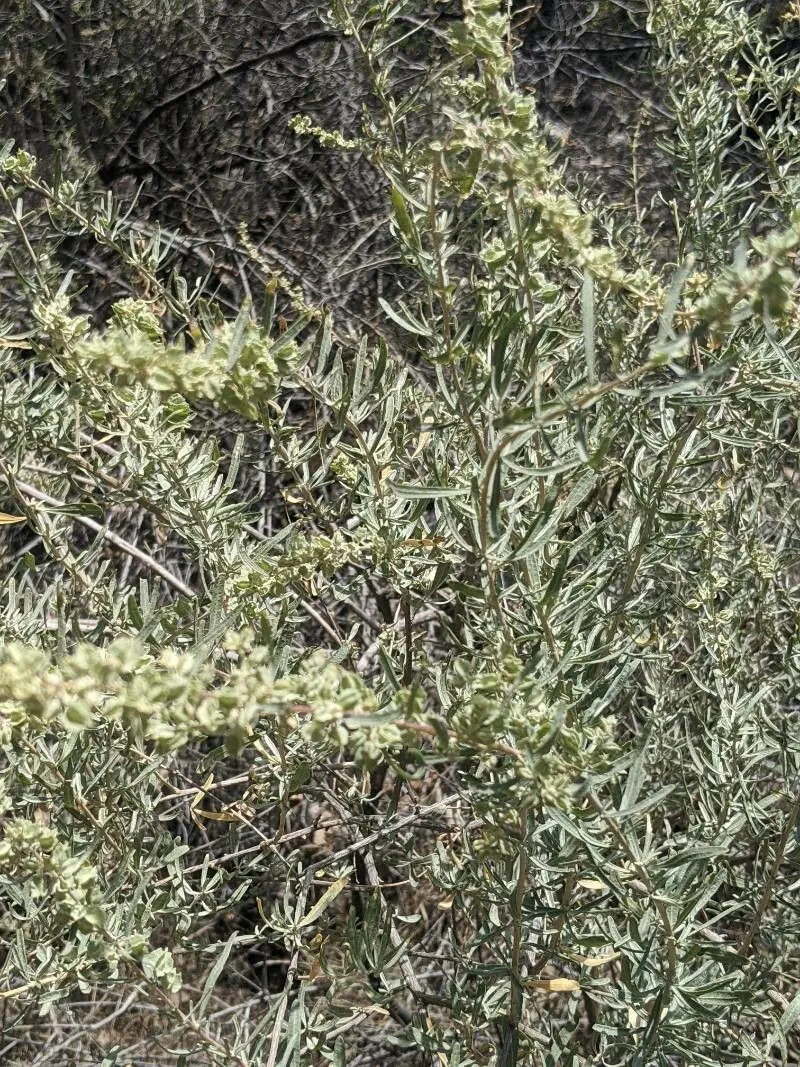
Author: (Pursh) Nutt.
Bibliography: Gen. N. Amer. Pl. 1: 197 (1818)
Year: 1818
Status: accepted
Rank: species
Genus: Atriplex
Vegetable: False
Observations: WC. Canada to Mexico
Four-wing saltbush, known scientifically as Atriplex canescens, is a versatile and resilient plant species belonging to the Amaranthaceae family. This bushy perennial is notable for its distinctive appearance and remarkable adaptability to a variety of environments, making it a valuable plant in both natural and cultivated settings.
Native to a broad geographic range that stretches from western Canada down through much of the United States and into Mexico, the Four-wing saltbush thrives in diverse conditions. Its ability to withstand extreme drought, saline soils, and high temperatures showcases its impressive hardiness. This resilience is a key factor in its widespread presence across arid and semi-arid regions, often forming an important component of the local flora.
Atriplex canescens is easily recognized by its silvery-grey foliage and distinctive seed bracts, which feature four prominent wings—hence the common name. The plant typically grows to a height of 1 to 3 meters, displaying an upright, branched structure that provides habitat and food for various wildlife species. The leaves are narrow and lance-shaped, coated with fine hairs that give the plant its characteristic greyish hue. These hairs also play a role in reducing water loss, further enhancing the plant’s drought tolerance.
The flowers of the Four-wing saltbush are small and inconspicuous, forming in dense clusters along the stems. The real spectacle, however, comes from its seed bracts, which turn a striking golden hue as they mature, adding an ornamental quality to this otherwise utilitarian plant.
Ecologically, Atriplex canescens is invaluable. It stabilizes soil and prevents erosion, particularly in desert landscapes and degraded lands. Additionally, it plays a crucial role in the diet of many herbivorous animals, providing a vital food source during the harshest conditions when other vegetation may be scarce. Its seeds are also consumed by birds and small mammals, making it an integral part of the food web.
Cultivationally, Four-wing saltbush holds promise for use in land reclamation and habitat restoration projects. Its ability to thrive in saline soils makes it a candidate for reclaiming areas affected by salinization, a growing concern in agricultural and natural landscapes. Its deep root system and robust growth habit enable it to anchor soils and restore organic matter, gradually improving soil health and fertility.
First described in 1818 in Genera of North American Plants by Frederick Pursh and later classified by Thomas Nuttall, Atriplex canescens embodies the resilience and beauty of plants adapted to survive in some of nature’s most challenging environments. Whether appreciated for its ecological contributions or its unique aesthetic characteristics, the Four-wing saltbush remains a noteworthy species in the plant kingdom.
Eng: fourwing saltbush, four-wing saltbush, shadscale
Deu: graue flügelmelde
Spa: cenizo, chamere, chamizo
Fra: arroche grisâtre
En: Four-wing saltbush, Shadscale, Fourwing saltbush
Fr: Arroche grisâtre
De: Graue Flügelmelde
Es: Chamere, Chamizo, Cenizo
Taken Dec 6, 2015 by EOL − matthew_salkiewicz (cc-by-nc)
Taken Dec 1, 1998 by EOL − Charles Webber (cc-by-nc-sa)
Taken Jun 7, 2000 by EOL − Charles Webber (cc-by-nc-sa)
Taken Nov 30, 2019 by Donald Huffman (cc-by-sa)
Taken Oct 27, 2022 by carol Williamson (cc-by-sa)
Taken Nov 18, 2019 by Heather Van Shaar (cc-by-sa)
Taken Nov 30, 2019 by Donald Huffman (cc-by-sa)
Taken Aug 9, 2022 by jpal (cc-by-sa)
Taken Oct 10, 2022 by david83400 (cc-by-sa)
Taken Mar 20, 2022 by Martin Bishop (cc-by-sa)
Taken Dec 4, 2013 by EOL − Ben VanderWeide (cc-by-nc)
Taken Jan 22, 2015 by EOL − Chuck Sexton (cc-by-nc)
Taken Sep 10, 2009 by EOL − Steve Matson (cc-by-nc)
Taken Nov 18, 2015 by EOL − matthew_salkiewicz (cc-by-nc)
Taken Nov 18, 2015 by EOL − matthew_salkiewicz (cc-by-nc)
Taken Aug 27, 2022 by Alexandra Prevost (cc-by-sa)
Taken Aug 27, 2022 by Alexandra Prevost (cc-by-sa)
Taken Oct 22, 2005 by EOL − Robert Sivinski (cc-by-nc)
Taken Jan 2, 2016 by EOL − dstotzer (cc-by-nc)
Taken Jul 17, 2015 by EOL − Jesse Rorabaugh (cc-by)
Taken Aug 13, 2015 by EOL − James Bailey (cc-by-nc)
Taken Aug 9, 2022 by jpal (cc-by-sa)
Taken Aug 9, 2022 by jpal (cc-by-sa)
© copyright of the Board of Trustees of the Royal Botanic Gardens, Kew.
© copyright of the Board of Trustees of the Royal Botanic Gardens, Kew.
© copyright of the Board of Trustees of the Royal Botanic Gardens, Kew.
Growth form: Multiple Stem
Growth habit: Shrub
Growth rate: Rapid
Ph maximum: 9.0
Ph minimum: 6.0
Family: Myrtaceae Author: (F.Muell.) K.D.Hill & L.A.S.Johnson Bibliography: Telopea 6: 402 (1995) Year: 1995 Status:…
Family: Rubiaceae Author: Pierre ex A.Froehner Bibliography: Notizbl. Bot. Gart. Berlin-Dahlem 1: 237 (1897) Year:…
Family: Sapindaceae Author: Koidz. Bibliography: J. Coll. Sci. Imp. Univ. Tokyo 32(1): 38 (1911) Year:…
Family: Asteraceae Author: A.Gray Bibliography: Pacif. Railr. Rep.: 107 (1857) Year: 1857 Status: accepted Rank:…
Family: Fabaceae Author: Medik. Bibliography: Vorles. Churpfälz. Phys.-Ökon. Ges. 2: 398 (1787) Year: 1787 Status:…
Family: Aspleniaceae Author: (Cav.) Alston Bibliography: Bull. Misc. Inform. Kew 1932: 309 (1932) Year: 1932…